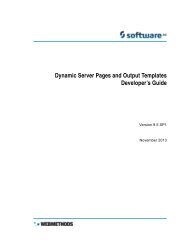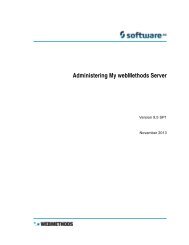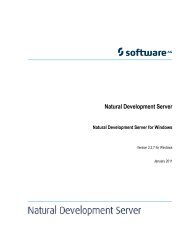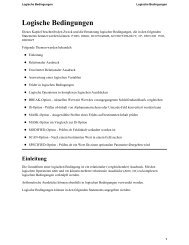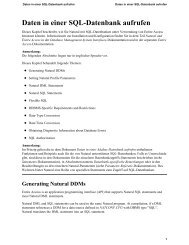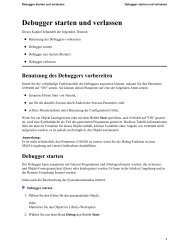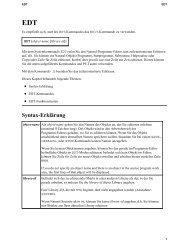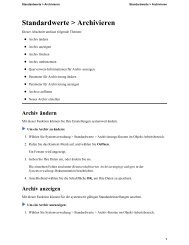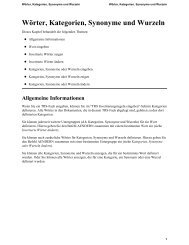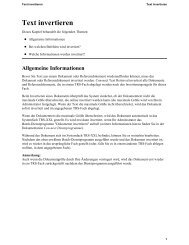Tamino XQuery User Guide - Software AG Documentation
Tamino XQuery User Guide - Software AG Documentation
Tamino XQuery User Guide - Software AG Documentation
You also want an ePaper? Increase the reach of your titles
YUMPU automatically turns print PDFs into web optimized ePapers that Google loves.
FLWOR Expressions<br />
Currently, there are 4 books stored.<br />
In a let clause each variable is bound directly to the result of an expression. A single tuple is then<br />
generated that contains all variable bindings. The return clause is evaluated once for this single<br />
tuple. As $a is bound to all instances of book elements, count($a) evaluates to the total number<br />
of books present in the collection. Since the return clause is invoked only once, we get the expected<br />
result. Now consider the same expression using the for clause:<br />
for $a in input()/bib/book<br />
return<br />
Currently, there are { count($a) } books stored.<br />
The result is:<br />
Currently, there are 1 books stored.<br />
Currently, there are 1 books stored.<br />
Currently, there are 1 books stored.<br />
Currently, there are 1 books stored.<br />
Instead of creating a single tuple, the for clause creates tuples of variable bindings from the<br />
Cartesian product of the sequence of items to which the expressions evaluate. In this example this<br />
means that the variable is bound to the evaluation of the expression input()/bib/book resulting<br />
in a sequence of four document instances. So $a is bound four times. For each of these bindings a<br />
tuple is generated and the return clause is called for each tuple. The count function only sees one<br />
document instance at a time.<br />
To further illustrate the processing of for clauses consider this example that is published in a<br />
similar form in the W3C <strong>XQuery</strong> specification:<br />
for $i in (1, 2),<br />
$j in (3, 4)<br />
return<br />
<br />
{ $i }<br />
{ $j }<br />
<br />
In the example before there is only one expression in the for clause so that the Cartesian product<br />
is equivalent to the sequence of items that the expression evaluates to. In this query you can see<br />
that the tuples of variable bindings are created from the Cartesian product of the sequences (1,<br />
2) and (3, 4):<br />
34<br />
<strong>XQuery</strong> <strong>User</strong> <strong>Guide</strong>



